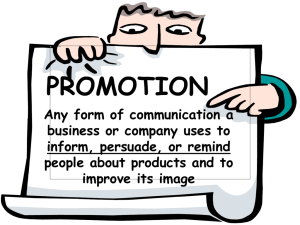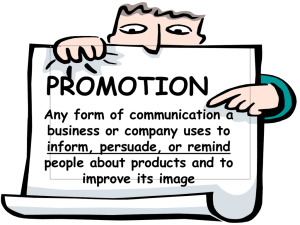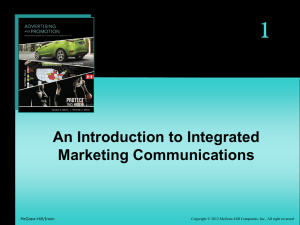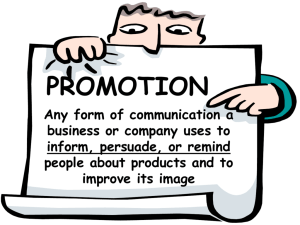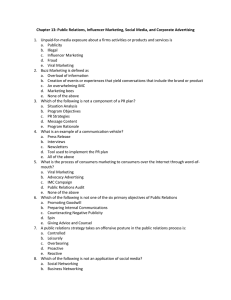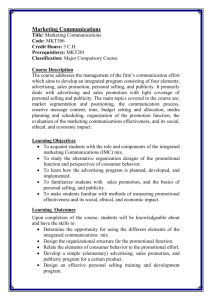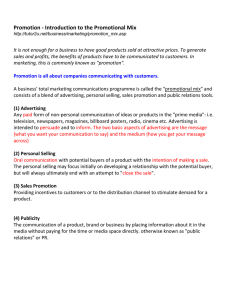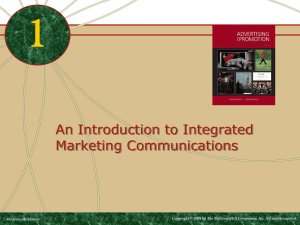Advertising & Promotion
advertisement
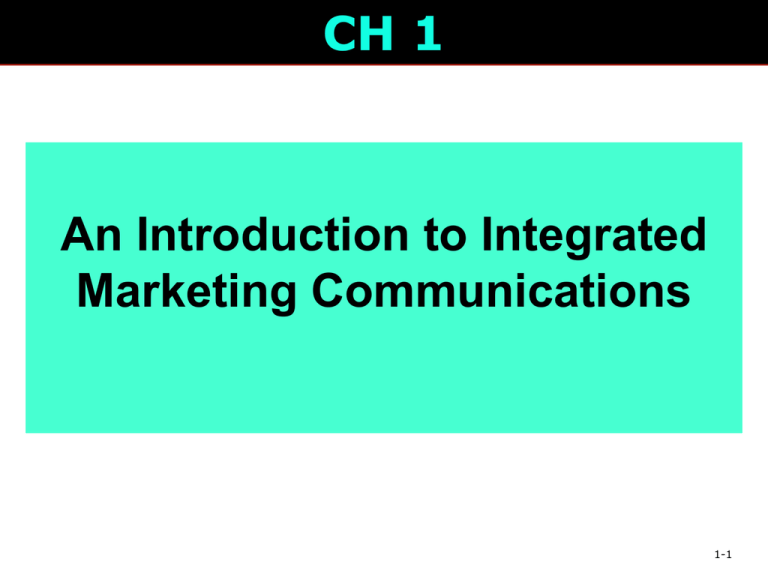
CH 1 An Introduction to Integrated Marketing Communications 1-1 The Modern World of Marketing • Rapidly changing media environment • Mass media losing viewers, readers, listeners • Digital media targets narrow audience • Consumers not content to be passive message recipients • Information now obtained from a myriad of sources 1-2 The Growth of Advertising and Promotion • Integral part of social and economic systems • Carefully prepared messages delivered to carefully targeted audiences • Six-fold increase between 1980 and 2010 • New marketing channels • Internet ads (banner ads, videos, webisodes) • Social media • Mobile marketing 1-3 The Role of Marketing Advertising & Promotion Inform customers of a product or service Convince them of its ability to satisfy their wants or needs Nonprofit Organizations Solicit donations Offer intangible social and psychological satisfactions Help develop and sustain relationships 1-4 What is Marketing? The activity, set of institutions, and processes for… creating, communicating, delivering, and exchanging offerings that have… value for customers, clients, partners, and society at large 1-5 What is Value? • Customer’s perception of all the benefits of a product or service • Benefits can be… 1-6 The Marketing Mix •The Four Ps 1-7 The Marketing Revolution Shift from traditional media ads to other forms of promotion/nontraditional media Internet and social media changing how companies interact with consumers Power shift: manufacturers to retailers Database marketing Movement away from mass media advertising toward more targeted tools such as event marketing, direct mail, Internet 1-8 The Role of IMC in Branding Image or Associations Name Performance Brand Identity Logo Packaging Design Symbols 1-9 The Promotional Mix Advertising Direct Marketing Interactive/ Internet Marketing Sales Promotion Publicity/ Public Relations Personal Selling 1-10 Advertising • Paid, nonpersonal communication • About an organization, product, service, or idea • With an identified sponsor • No immediate feedback from audience 1-11 Non-Personal Media • Mass media • TV • Radio • Magazines • Newspapers • Benefits • Cost effective • Large audiences 1-12 Advertising Classifications National Retail / Local Consumers Primary / Selective Demand Business-to-Business Professional Trade Organizations 1-13 Forms of Direct Marketing Direct Mail Catalogs Telemarketing Database Management Direct Response Ads Direct Selling Shopping Channels Internet Sales 1-14 Direct Response Advertising • Encourages consumers to purchase directly from the manufacturer 1-15 Direct Response Advertising Major Tools Forces for Change 1-16 Interactive Marketing • Interactive media • Internet • Kiosks • Interactive television • Cell phones • Other mobile devices 1-17 Interactive Marketing • Internet activities • Advertise products and services • Link ads and websites to search engines • Offer coupons, contests, sweepstakes • Conduct direct marketing • Do personal selling • Conduct public relations activities • Measure advertising and promotions 1-18 Consumer vs. Trade Promotions Consumeroriented Encourages immediate purchases Tradeoriented Wholesalers, distributors, retailers 1-19 Publicity A news story, editorial, or High credibility and announcement to low cost a mass audience Not directly paid for or run under identified sponsor Is sometimes unfavorable Not always under company control 1-20 Public Relations • Uses publicity and other tools 1-21 Personal Selling • Person-to-person communication • A seller attempts to assist and/or persuade prospective buyers to make a purchase or act on an idea 1-22 Touch Points: Control vs. Impact 1-23 IMC Planning Model Review of marketing plan Promotional program situation analysis Analysis of the communications process Budget determination Develop integrated marketing communications programs Advertising Sales promotion PR/ publicity Personal selling Direct marketing Internet/ interactive Advertising objectives Sales promotion objectives PR/ publicity objectives Personal selling objectives Direct marketing objectives Internet/ interactive objectives Message strategy Sales promotion strategy PR/ publicity strategy Personal selling strategy Direct marketing strategy Internet/ interactive strategy Integrate and implement marketing communications strategies Monitor, evaluate and control IMC Program 1-24 Elements of a Marketing Plan Detailed situation analysis Specific marketing objectives Marketing strategy and program Program for implementing the strategy Process for monitoring & evaluating performance 1-25 Promotional Program Situational Analysis Internal External Firm’s promotional organization/capabilities Customer analysis Review of previous programs and results Environmental analysis Competitive analysis Assess firm/brand image Assess strengths and weaknesses of product or service 1-26 Analysis of Communications Process • Communication decisions • Source and message • Communication channels • Media mix • Costs • Marketing goals • Communication objectives 1-27 Budget Determination • What will the promotional program cost? • How will the money be allocated? 1-28 Developing the IMC Program IMC Strategies Creative Media 1-29 Monitoring, Evaluation, Control Basic Goals Determine how well the program is doing, and why Problem correction Continual management feedback Input for future promotions/strategies 1-30
